The Ultimate Guide to Growing Garlic at Home
Go4Turf
February 13, 2024
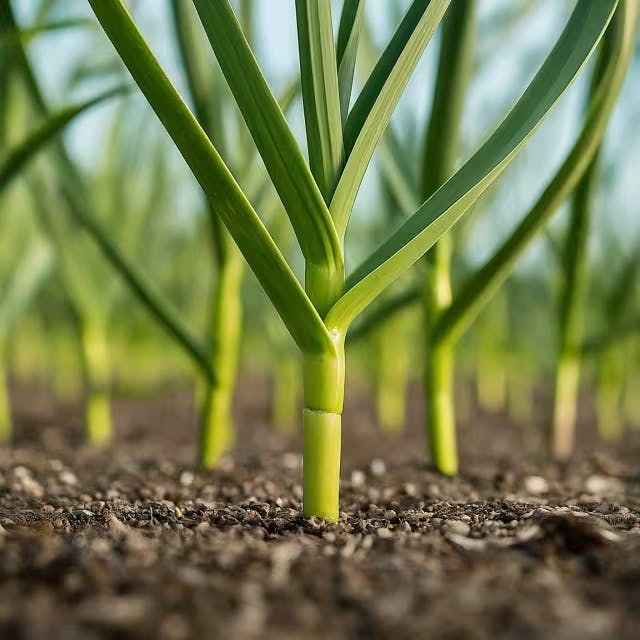
Welcome to "The Ultimate Guide to Growing Garlic at Home," where we delve into the enriching world of cultivating your own garlic. Revered for its health benefits and indispensable culinary role, garlic presents an exciting venture with its ease of cultivation, making it a perfect addition to home gardens. Whether you're fascinated by the robust flavors of hardneck varieties or the long shelf life of softnecks, this guide ensures you're well-equipped with the knowledge to prepare your soil, choose the right garlic variety, plant with confidence, and ultimately, harvest and store your garlic successfully.
Key Takeaways
Select the right garlic variety—hardnecks for robust flavors and cold climates, softnecks for milder taste and longer storage.
Prepare your soil with ample organic matter and ensure proper drainage to foster healthy garlic growth.
Follow best planting practices: plant in the fall, position cloves pointed-end up, and space adequately.
Provide consistent care by mulching, watering when necessary, and removing weeds to support your garlic plants.
Harvest your garlic when the lower leaves begin to brown but several green leaves remain, signaling maturity.
Cure garlic properly post-harvest to extend its shelf life and maintain flavor.
Choosing the Right Garlic Variety for Your Garden
Deciding on the right garlic variety for your home garden hinges on climate adaptability and personal taste preferences. Hardneck and softneck types cater to cool and warm regions, respectively. Hardnecks are known for their bold flavors and vibrant bulbs, while softnecks provide longer storage. For gardeners in cooler climates, hardneck varieties like 'Music' and 'Korean Red' are excellent choices. They withstand the cold well and reward growers with both cloves and flavorful garlic scapes. On the other hand, those in milder areas might lean towards softneck types, such as 'California Early' or 'Silverskin', known for their larger bulbs and extended shelf life.
Variety Type | Suitable Climate | Features |
Hardneck | Cooler | Bold flavors, scapes |
Softneck | Warmer | Larger bulbs, long-lasting |
Additionally, elephant garlic presents a unique option for those seeking milder flavors and enormous cloves - a perfect choice for gardeners aiming to experiment.
Opting for regionally adapted "seed garlic" enhances growth outcomes. Store-bought cloves might not always suit your local climate, potentially impacting your success. For detailed gardening tips that ensure plant health and adaptability, explore articles like Transform Your Black Thumb into a Green Thumb: Essential Tips and Preparing Your Garden for Fall: Tips and Tricks, which highlight the importance of choosing the right plants for your garden's success.
For further insights on garlic types and expert recommendations, visit Oregon State University’s guide, Savvy Gardening, and Joe Gardener, which delve into the nuanced differences and cultivation tips for various garlic varieties. These resources are invaluable for both novice and seasoned gardeners aiming to enrich their gardens with this versatile and beloved plant.
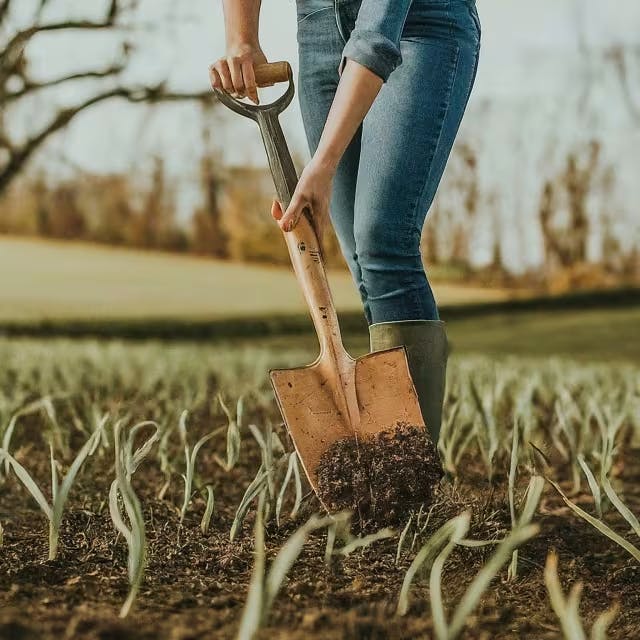
Preparing Your Soil for Garlic Planting
To ensure a successful garlic harvest, starting with well-prepared soil is a must. Garlic thrives in loose, fertile dirt with excellent drainage. Begin by working the soil to a depth of about 12 inches to allow for proper root expansion. Incorporate a generous amount of organic compost to enrich the soil with nutrients essential for garlic growth.
Check the soil pH; garlic prefers a range between 6.0 and 7.0. Adjust accordingly with lime or sulfur based on your soil test results. Proper soil preparation not only encourages robust garlic plants but also helps avoid many common soil-borne diseases.
For more insights on enhancing your garden's health and ensuring nutrient-rich soil, consider reading Transform Your Black Thumb into a Green Thumb: Essential Tips, which offers valuable advice for gardeners of all levels.
Remember, too much moisture can be detrimental, leading to root rot. Ensure your planting site does not collect standing water. If you're dealing with heavy clay soil, raised beds may be an excellent solution to provide your garlic with the environment it needs to thrive.
Lastly, garlic benefits from the application of a balanced, slow-release fertilizer at planting time. However, avoid high-nitrogen fertilizers as they encourage more leaf growth than bulb development. A balanced approach to soil preparation sets the stage for a bountiful garlic harvest and contributes to an overall vibrant, healthy garden landscape.
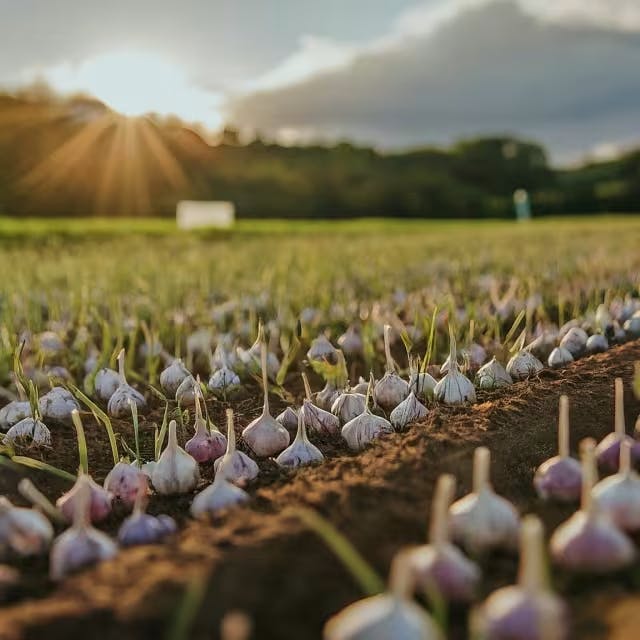
Planting Garlic: Best Practices to Follow
When embarking on your garlic-growing journey, choosing the right planting conditions is paramount for success. Begin by selecting a sunny spot with well-draining soil to avoid waterlogging, which garlic despises. If your garden soil is heavy, consider adding compost to improve drainage and structure. This preparation step aligns with essential gardening practices highlighted in Transform Your Black Thumb into a Green Thumb: Essential Tips, emphasizing the importance of sunlight, water, and nutrient management for plant health.
Incorporating weed management strategies is equally crucial, as garlic competes poorly with weeds, especially during its early growth stages. Opt for pre-planting methods like the stale seedbed technique or soil solarization to minimize weed pressure. These methods have been identified as effective in an integrated weed management program tailored for onion and garlic, showcasing their vulnerability to weed competition and the high costs associated with manual weeding.
Key Activity | Description |
Soil Preparation | Enhance drainage with compost. Ensure a sunny location. |
Weed Management | Use pre-planting weed control methods such as the stale seedbed technique or soil solarization. |
When planting, ensure you plant garlic cloves pointy-end up, about 2 inches deep and 4-6 inches apart. This spacing facilitates ample growth room and air circulation around the plants, critical for preventing fungal diseases. After planting, mulch the bed to conserve moisture, stabilize soil temperature, and further suppress weed growth.
As the season changes and you prepare for fall, consider tips from Preparing Your Garden for Fall: Tips and Tricks, which could aid in transitioning your garlic and other plants into the colder months seamlessly. The cultivation of garlic at home requires attention to these detailed aspects, blending general gardening wisdom with garlic-specific best practices for a fruitful harvest.
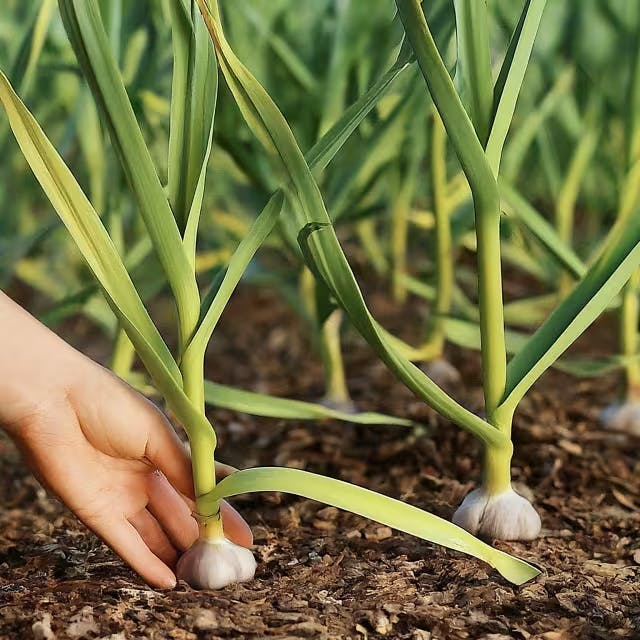
Caring for Your Growing Garlic Plants
Maintaining the health of your garlic plants requires consistent care and attention. Proper watering is crucial; garlic prefers soil that is moist but not waterlogged. Overwatering can lead to root rot, so it’s important to let the soil dry out slightly between watering sessions. Here are some tips for ensuring your garlic plants thrive:
Watering: Aim for 1 inch of water per week, either from rainfall or manual watering. Use a drip irrigation system or water at the base of the plants to avoid wetting the foliage, which can encourage diseases.
Weeding: Keep the area around your garlic plants free from weeds. Weeds compete with garlic for nutrients and water. Hand-pull or use a hoe carefully to avoid damaging the garlic bulbs.
Mulching: Apply a layer of organic mulch, such as straw or grass clippings, around your garlic plants. This helps retain soil moisture, suppresses weeds, and provides nutrients as it breaks down.
Feeding: While garlic is not a heavy feeder, a balanced fertilizer applied at planting and again in the spring can encourage stronger growth. Learn essential gardening tips to ensure plant health and growth, including the use of fertilizers.
Pest and Disease Management: Inspect your plants regularly for signs of pests or disease. Common garlic pests include nematodes and onion maggots, while rust and botrytis rot are notable diseases. Practice crop rotation and use disease-resistant varieties to minimize issues.
By adhering to these care practices, you can nurture your garlic plants effectively, ensuring a bountiful harvest. For gardeners looking to prepare their garden for the changing seasons, insights on transitioning your garden for fall, including watering and soil care tips, are invaluable.
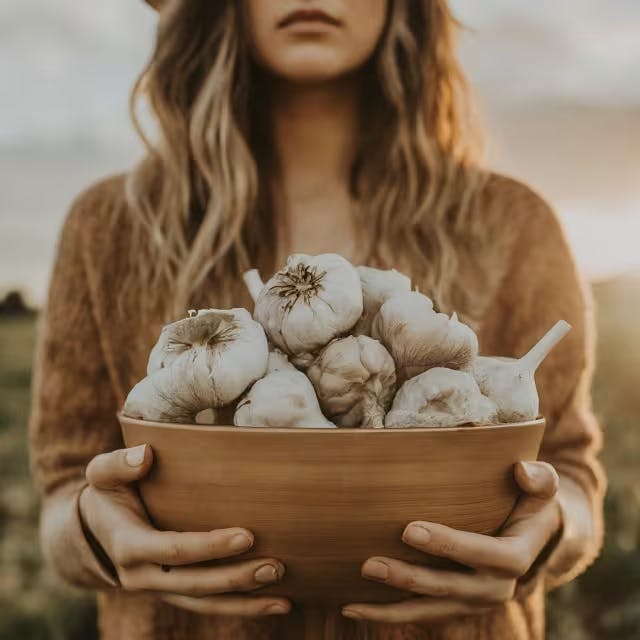
Harvesting and Storing Garlic Successfully
Knowing when and how to harvest garlic is crucial for optimizing flavor and storability. Generally, garlic is ready to harvest when the lower leaves start to brown. This typically happens in late spring or summer, depending on your climate. A soft neck is an indicator of readiness in softneck varieties, while the drying of lower leaves signifies the same for hardneck varieties.
After digging up the bulbs, it's advised to let them cure. Curing involves drying the garlic in a well-ventilated, dry area out of direct sunlight for a few weeks. This process is essential for extending their shelf life.
Storing garlic properly is just as important as the right harvesting method. Once cured, keep the bulbs in a cool, dry place with plenty of air circulation. Avoid storing garlic in plastic bags or containers as this can promote mold and sprouting.
For those looking to enhance their gardening skills further, integrating knowledge from other areas can be beneficial. For instance, learning about proper sunlight, water, and nutrient management can significantly impact garlic yield. These essentials can be grasped in detail by reading about how to transform your gardening skills.
Moreover, as different seasons require different care strategies for plants, understanding how to prepare your garden for fall can also aid in planning your garlic planting and harvesting accordingly. Learn more about this by reading tips and tricks for garden preparation.
Finally, exploring the nuances of growing other plants, such as ginger and galangal, can also provide insights relevant to garlic cultivation. Discover more about this by checking out this detailed guide. In summary, The Ultimate Guide to Growing Garlic at Home underscores the significance of selecting a garlic variety suited to your climate and taste preferences, alongside preparing your soil and adopting best practices for planting, caring, and harvesting. Equipped with knowledge on everything from soil preparation to proper storage, you're now well-poised to embark on a rewarding journey of growing garlic in your own garden, guaranteeing a fresh, flavorful supply for your culinary adventures.
Frequently Asked Questions
What are the best garlic varieties to grow in different climates?
For cooler climates, hardneck garlic varieties like 'Music' and 'Korean Red' are recommended due to their cold resistance and flavorful scapes. In warmer regions, softneck varieties such as 'California Early' and 'Silverskin' are preferable for their larger bulbs and longer shelf life. Elephant garlic is another choice, offering milder flavors and large cloves, suitable for those wanting to experiment. It's important to select "seed garlic" adapted to your region for optimal growth and success.
How should you prepare soil for planting garlic in your home garden?
To prepare soil for planting garlic, ensure it's well-draining and rich in organic matter. Work the soil to a depth of about 12 inches and incorporate plenty of compost to provide nutrients. Check the pH levels to maintain between 6.0 and 7.0, adjusting with lime or sulfur as needed. Avoid heavy clay soils that retain moisture; consider raised beds if drainage is an issue. Finally, apply a balanced, slow-release fertilizer at planting but steer clear of high-nitrogen options to promote bulb rather than leaf growth.
What are the essential care tips for maintaining healthy garlic plants at home?
Maintaining healthy garlic plants at home involves selecting the right variety for your climate, either hardneck for cooler areas or softneck for warmer regions. Prepare well-drained, fertile soil with a pH between 6.0 and 7.0 and plant cloves in a sunny location. Watering should aim for 1 inch per week without overwatering, and mulching helps retain soil moisture and suppress weeds. Regular weeding and the use of organic compost will enrich the soil, while monitoring for pests and diseases is crucial. Additionally, choosing regionally adapted "seed garlic" can significantly enhance growth outcomes.
How and when should you harvest garlic for optimal flavor and storability?
Harvest garlic when the lower leaves start to brown, typically in late spring or summer. Dig up the bulbs carefully, then cure them in a dry, well-ventilated area away from direct sunlight for a few weeks to extend shelf life. Store the cured garlic in a cool, dry place with good air circulation, avoiding plastic bags or containers to prevent mold and sprouting.
What are the key steps for curing and storing garlic to ensure longevity?
To ensure garlic's longevity post-harvest, initially cure the bulbs by drying them in a well-ventilated, shady area for a few weeks. After curing, store the garlic in a cool, dry place with good air circulation. It is crucial to avoid using plastic bags or containers for storage, as these can trigger mold growth and sprouting.